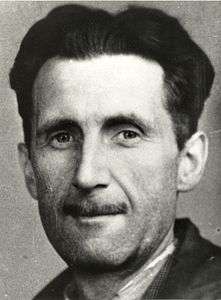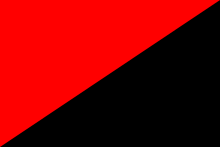Spanish Revolution of 1936
The Spanish Revolution was a workers' social revolution that began during the outbreak of the Spanish Civil War in 1936 and resulted in the widespread implementation of anarchist and more broadly libertarian socialist organizational principles throughout various portions of the country for two to three years, primarily Catalonia, Aragon, Andalusia, and parts of the Valencian Community. Much of the economy of Spain was put under worker control; in anarchist strongholds like Catalonia, the figure was as high as 75%, but lower in areas with heavy influence by the Communist Party of Spain. Factories were run through worker committees, and agrarian areas became collectivized and run as libertarian socialist communes. Many small businesses like hotels, barber shops, and restaurants were also collectivized and managed by their workers.
| Spanish Revolution | |
|---|---|
| Part of the Spanish Civil War | |
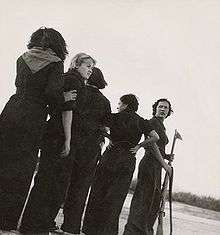 Women training for a militia outside Barcelona, August 1936. | |
| Location | Various regions of Spain – primarily Madrid, Catalonia, Anarchist Aragon, Andalusia, and parts of Levante, Spain. |
| Goals | Elimination of all institutions of state power; worker control of industrial production; implementation of libertarian socialist economy; elimination of social influence from Catholic Church; international spread of revolution to neighboring regions. |
| Methods | Work place collectivization; political assassination |
| Resulted in | Suppressed after ten-month period. |
Overview
Sam Dolgoff estimated that about eight million people participated directly or at least indirectly in the Spanish Revolution,[1] which he claimed "came closer to realizing the ideal of the free stateless society on a vast scale than any other revolution in history."[2] Dolgoff quotes the French anarchist historian Gaston Leval (who was an active participant) to summarize the anarchist conception of the social revolution:
In Spain during almost three years, despite a civil war that took a million lives, despite the opposition of the political parties (republicans, left and right Catalan separatists, socialists, Communists, Basque and Valencian regionalists, petty bourgeoisie, etc.), this idea of libertarian communism was put into effect. Very quickly more than 60% of the land was collectively cultivated by the peasants themselves, without landlords, without bosses, and without instituting capitalist competition to spur production. In almost all the industries, factories, mills, workshops, transportation services, public services, and utilities, the rank and file workers, their revolutionary committees, and their syndicates reorganized and administered production, distribution, and public services without capitalists, high salaried managers, or the authority of the state.
The various agrarian and industrial collectives immediately instituted economic equality in accordance with the essential principle of communism, 'From each according to his ability and to each according to his needs.' They coordinated their efforts through free association in whole regions, created new wealth, increased production (especially in agriculture), built more schools, and bettered public services. They instituted not bourgeois formal democracy but genuine grass roots functional libertarian democracy, where each individual participated directly in the revolutionary reorganization of social life. They replaced the war between men, 'survival of the fittest,' by the universal practice of mutual aid, and replaced rivalry by the principle of solidarity....
This experience, in which about eight million people directly or indirectly participated, opened a new way of life to those who sought an alternative to anti-social capitalism on the one hand, and totalitarian state bogus socialism on the other.[3]
The collectivization effort was primarily orchestrated by the rank-and-file members of the Confederación Nacional del Trabajo (CNT; English: National Confederation of Labor) and the Federación Anarquista Ibérica (FAI; English: Iberian Anarchist Federation), with the two often abbreviated as CNT–FAI due to the affinity between the two organizations and the major role of the latter within the former in maintaining anarchist "purity." The non-anarchist socialist Unión General de Trabajadores (UGT; English: General Union of Workers) also participated in the implementation of collectivization, albeit to a far lesser degree.
Orwell's account
The British author George Orwell, best known for his anti-authoritarian works Animal Farm and Nineteen Eighty-Four, was a soldier in the militia of the CNT-allied Partido Obrero Unificación Marxista (POUM; English: Workers' Party of Marxist Unification). Orwell meticulously documented his first-hand observations of the civil war, and expressed admiration for the social revolution in his book Homage to Catalonia.[4]
I had dropped more or less by chance into the only community of any size in Western Europe where political consciousness and disbelief in capitalism were more normal than their opposites. Up here in Aragon one was among tens of thousands of people, mainly though not entirely of working-class origin, all living at the same level and mingling on terms of equality. In theory it was perfect equality, and even in practice it was not far from it. There is a sense in which it would be true to say that one was experiencing a foretaste of Socialism, by which I mean that the prevailing mental atmosphere was that of Socialism. Many of the normal motives of civilized life—snobbishness, money-grubbing, fear of the boss, etc.—had simply ceased to exist. The ordinary class-division of society had disappeared to an extent that is almost unthinkable in the money-tainted air of England; there was no one there except the peasants and ourselves, and no one owned anyone else as his master.
Continuing, Orwell describes the general feeling of the new society that was built within the shell of the old, offering specific elaborations on the effective destruction of hierarchical arrangements that he had perceived in anarchist Spain.
This was in late December 1936, less than seven months ago as I write, and yet it is a period that has already receded into enormous distance. Later events have obliterated it much more completely than they have obliterated 1935, or 1905, for that matter. I had come to Spain with some notion of writing newspaper articles, but I had joined the militia almost immediately, because at that time and in that atmosphere it seemed the only conceivable thing to do. The Anarchists were still in virtual control of Catalonia and the revolution was still in full swing. To anyone who had been there since the beginning it probably seemed even in December or January that the revolutionary period was ending; but when one came straight from England the aspect of Barcelona was something startling and overwhelming. It was the first time that I had ever been in a town where the working class was in the saddle. Practically every building of any size had been seized by the workers and was draped with red flags and with the red and black flag of the Anarchists; every wall was scrawled with the hammer and sickle and with the initials of the revolutionary parties; almost every church had been gutted and its images burnt. Churches here and there were being systematically demolished by gangs of workmen. Every shop and cafe had an inscription saying that it had been collectivized; even the bootblacks had been collectivized and their boxes painted red and black. Waiters and shop-walkers looked you in the face and treated you as an equal. Servile and even ceremonial forms of speech had temporarily disappeared. Nobody said 'Señor' or 'Don' or even 'Usted'; everyone called everyone else 'Comrade' or 'Thou', and said 'Salud!' instead of 'Buenos días'. Tipping had been forbidden by law since the time of Primo de Rivera; almost my first experience was receiving a lecture from a hotel manager for trying to tip a lift-boy. There were no private motor-cars, they had all been commandeered, and the trams and taxis and much of the other transport were painted red and black. The revolutionary posters were everywhere, flaming from the walls in clean reds and blues that made the few remaining advertisements look like daubs of mud. Down the Ramblas, the wide central artery of the town where crowds of people streamed constantly to and from, the loud-speakers were bellowing revolutionary songs all day and far into the night. And it was the aspect of the crowds that was the queerest thing of all. In outward appearance it was a town in which the wealthy classes had practically ceased to exist. Except for a small number of women and foreigners there were no 'well-dressed' people at all. Practically everyone wore rough working-class clothes, or blue overalls or some variant of militia uniform. All this was queer and moving. There was much in this that I did not understand, in some ways I did not even like it, but I recognized it immediately as a state of affairs worth fighting for...so far as one could judge the people were contented and hopeful. There was no unemployment, and the price of living was still extremely low; you saw very few conspicuously destitute people, and no beggars except the gypsies. Above all, there was a belief in the revolution and the future, a feeling of having suddenly emerged into an era of equality and freedom. Human beings were trying to behave as human beings and not as cogs in the capitalist machine."
Orwell was a democratic socialist and a left-libertarian sympathizer who expressed solidarity with the anarchist movement and social revolution, later commenting, "I had told everyone for a long time past that I was going to leave the P.O.U.M. As far as my purely personal preferences went I would have liked to join the Anarchists."[5]
Social revolution
The most notable aspect of the social revolution was the establishment of a libertarian socialist economy based on coordination through decentralized and horizontal federations of participatory industrial collectives and agrarian communes. Here are just a few opinions of foreign journalists who have no personal connection with the Anarchist movement. Thus, Andrea Oltmares,[6] professor in the University of Geneva, in the course of an address of some length, said:
"In the midst of the civil war the Anarchists have proved themselves to be political organizers of the first rank. They kindled in everyone the required sense of responsibility, and knew how, by eloquent appeals, to keep alive the spirit of sacrifice for the general welfare of the people. "As a Social Democrat I speak here with inner joy and sincere admiration of my experiences in Catalonia. The anti-capitalist transformation took place here without their having to resort to a dictatorship. The members of the syndicates are their own masters and carry on the production and the distribution of the products of labor under their own management, with the advice of technical experts in whom they have confidence. The enthusiasm of the workers is so great that they scorn any personal advantage and are concerned only for the welfare of all."
The well-known anti-Fascist, Carlo Rosselli,[6] who before Mussolini's accession to power was Professor of Economics in the University of Genoa, put his judgment into the following words:
In three months Catalonia has been able to set up a new social order on the ruins of an ancient system. This is chiefly due to the Anarchists, who have revealed a quite remarkable sense of proportion, realistic understanding, and organising ability...all the revolutionary forces of Catalonia have united in a program of Syndicalist-Socialist character: socialisation of large industry; recognition of the small proprietor, workers' control...Anarcho-Syndicalism, hitherto so despised, has revealed itself as a great constructive force...I am not an Anarchist, but I regard it as my duty to express here my opinion of the Anarchists of Catalonia, who have all too often been represented to the world as a destructive, if not criminal, element. I was with them at the front, in the trenches, and I have learnt to admire them. The Catalan Anarchists belong to the advance guard of the coming revolution. A new world was born with them, and it is a joy to serve that world.
And Fenner Brockway,[6] Secretary of the I.L.P. in England who traveled to Spain after the May events in Catalonia (1937), expressed his impressions in the following words:
"I was impressed by the strength of the C.N.T. It was unnecessary to tell me that it was the largest and most vital of the working-class organisations in Spain. The large industries were clearly, in the main, in the hands of the C.N.T.--railways, road transport, shipping, engineering, textiles, electricity, building, agriculture. At Valencia the U.G.T. had a larger share of control than at Barcelona, but generally speaking the mass of manual workers belonged to the C.N.T. The U.G.T. membership was more of the type of the 'white-collar' worker...I was immensely impressed by the constructive revolutionary work which is being done by the C.N.T. Their achievement of workers' control in industry is an inspiration. One could take the example of the railways or engineering or textiles...There are still some Britishers and Americans who regard the Anarchists of Spain as impossible, undisciplined, uncontrollable. This is poles away from the truth. The Anarchists of Spain, through the C.N.T., are doing one of the biggest constructive jobs ever done by the working class. At the front they are fighting Fascism. Behind the front they are actually constructing the new Workers' Society. They see that the war against Fascism and the carrying through of the Social Revolution are inseparable. Those who have seen and understand what they are doing must honour them and be grateful to them. They are resisting Fascism. They are at the same time creating the New Workers' Order which is the only alternative to Fascism. That is surely the biggest things now being done by the workers in any part of the world." And in another place: "The great solidarity that existed amongst the Anarchists was due to each individual relying on his own strength and not depending on leadership. The organisations must, to be successful, be combined with a free-thinking people; not a mass, but free individuals."
- — All three cited in: Rudolf Rocker, Anarcho-Syndicalism, original 1938, AK Press edition, page 66–67.
This was accomplished through widespread expropriation and collectivization of privately owned productive resources (and some smaller structures), in adherence to the anarchist belief that private property is authoritarian in nature. Spanish Civil War scholar (and anti-socialist) Burnett Bolloten writes of this process:[7]
The economic changes that followed the military insurrection were no less dramatic than the political. In those provinces where the revolt had failed the workers of the two trade union federations, the Socialist UGT and the Anarchosyndicalist CNT, took into their hands a vast portion of the economy. Landed properties were seized; some were collectivized, others were distributed among the peasants, and notarial archives as well as registers of property were burnt in countless towns and villages. Railways, tramcars and buses, taxicabs and shipping, electric light and power companies, gasworks and waterworks, engineering and automobile assembly plants, mines and cement works, textile mills and paper factories, electrical and chemical concerns, glass bottle factories and perfumeries, food-processing plants and breweries, as well as a host of other enterprises, were confiscated or controlled by workmen's committees, either term possessing for the owners almost equal significance in practice. Motion-picture theatres and legitimate theatres, newspapers and printing shops, department stores and bars, were likewise sequestered or controlled as were the headquarters of business and professional associations and thousands of dwellings owned by the upper class.
The economic policies of the anarchist collectives were primarily operated according to the basic communist principle of "From each according to his ability, to each according to his need". In some places, money was entirely eliminated, to be replaced with vouchers and coupons distributed on the basis of needs rather than individual labor contributions. Bolloten writes of this process also:[8]
In many communities money for internal use was abolished, because, in the opinion of Anarchists, "money and power are diabolical philtres, which turn a man into a wolf, into a rabid enemy, instead of into a brother." "Here in Fraga [a small town in Aragon], you can throw banknotes into the street," ran an article in a Libertarian paper, "and no one will take any notice. Rockefeller, if you were to come to Fraga with your entire bank account you would not be able to buy a cup of coffee. Money, your God and your servant, has been abolished here, and the people are happy." In those Libertarian communities where money was suppressed, wages were paid in coupons, the scale being determined by the size of the family. Locally produced goods, if abundant, such as bread, wine, and olive oil, were distributed freely, while other articles could be obtained by means of coupons at the communal depot. Surplus goods were exchanged with other Anarchist towns and villages, money being used only for transactions with those communities that had not adopted the new system.
Bolloten also quoted anarchist journalist Augustin Souchy that "The characteristic of the majority of CNT collectives is the family wage. Wages are paid according to the needs of the members and not according to the labor performed by each worker."[8] This focus on the needs of members made these conditions anarcho-communist.
Despite the critics clamoring for "maximum efficiency" rather than revolutionary methods, anarchist collectives often produced more than before the collectivization. In Aragon, productivity increased by 20%.[9] The newly liberated zones worked on entirely libertarian principles; decisions were made through councils of ordinary citizens without any bureaucracy. The CNT–FAI leadership was much less radical than rank and file members responsible for these sweeping changes.
The social effects of the revolution were less drastic than the economic ones however; while there were some social changes in larger urban areas (Barcelona emphasised a "proletarian style" and Catalonia set up inexpensive abortion facilities), the attitudes of the lower classes remained fairly conservative and there was comparatively little emulation of Russian-style "revolutionary morality".[10]
As the war dragged on, the spirit of the revolution's early days flagged. In part, this was due to the policies of the Communist Party of Spain, which took its cues from the foreign ministry of Joseph Stalin's Soviet Union, the source of most of the foreign aid received by the Republican side. The Communist policy was that abolition of capitalism should be addressed only after the war. But for the other left-wing parties, particularly the anarchists and POUM, the war and the revolution were the same. Militias of groups which were outspoken against the Soviet position soon found Soviet aid cut off. Partly due to this, the situation in most Republican-held areas slowly began to revert largely to its prewar conditions; in many ways the revolution was over well before Franco's victory in early 1939.
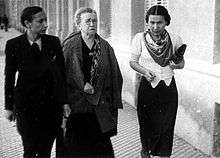
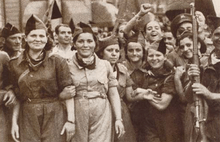 FAI milicia during Spanish Social Revolution.
FAI milicia during Spanish Social Revolution.
Environmentalism
The Spanish Revolution undertook several environmental reforms which were possibly the largest in the world at the time. Daniel Guerin notes that anarchist territories would diversify crops, extend irrigation, initiate reforestation and start tree nurseries.[11] Once there was a link discovered between air pollution and tuberculosis, the CNT shut down several metal factories.[12]
Criticisms
Criticism of the Spanish Revolution has primarily centered around allegations of coercion by anarchist participants (primarily in the rural collectives of Aragon), which critics charge run contrary to libertarian organizational principles. Bolloten claims that CNT–FAI reports overplayed the voluntary nature of collectivization, and ignored the more widespread realities of coercion or outright force as the primary characteristic of anarchist organization.[13]
Although CNT-FAI publications cited numerous cases of peasant proprietors and tenant farmers who had adhered voluntarily to the collective system, there can be no doubt that an incomparably larger number doggedly opposed it or accepted it only under extreme duress...The fact is...that many small owners and tenant farmers were forced to join the collective farms before they had an opportunity to make up their minds freely.
He also emphasizes the generally coercive nature of the war climate and anarchist military organization and presence in many portions of the countryside as being an element in the establishment of collectivization, even if outright force or blatant coercion was not used to bind participants against their will.[14]
Even if the peasant proprietor and tenant farmer were not compelled to adhere to the collective system, there were several factors that made life difficult for recalcitrants; for not only were they prevented from employing hired labor and disposing freely as their crops, as has already been seen, but they were often denied all benefits enjoyed by members...Moreover, the tenant farmer, who had believed himself freed from the payment of rent by the execution or flight of the landowner or of his steward, was often compelled to continue such payment to the village committee. All these factors combined to exert a pressure almost as powerful as the butt of the rifle, and eventually forced the small owners and tenant farmers in many villages to relinquish their land and other possessions to the collective farms.
This charge had previously been made by historian Ronald Fraser in his Blood of Spain: An Oral History of the Spanish Civil War, who commented that direct force was not necessary in the context of an otherwise coercive war climate.[15]
[V]illagers could find themselves under considerable pressure to collectivize - even if for different reasons. There was no need to dragoon them at pistol point: the coercive climate, in which 'fascists' were being shot, was sufficient. 'Spontaneous' and 'forced' collectives existed, as did willing and unwilling collectivists within them. Forced collectivization ran contrary to libertarian ideals. Anything that was forced could not be libertarian. Obligatory collectivization was justified, in some libertarians' eyes, by a reasoning closer to war communism than to libertarian communism: the need to feed the columns at the front.
Anarchist sympathizers counter that the presence of a "coercive climate" was an unavoidable aspect of the war that the anarchists cannot be fairly blamed for, and that the presence of deliberate coercion or direct force was minimal, as evidenced by a generally peaceful mixture of collectivists and individualist dissenters who had opted not to participate in collective organization. The latter sentiment is expressed by historian Antony Beevor in his Battle for Spain: The Spanish Civil War, 1936–1939.[16]
The justification for this operation (whose "very harsh measures" shocked even some Party members) was that since all the collectives had been established by force, Líster was merely liberating the peasants. There had undoubtedly been pressure, and no doubt force was used on some occasions in the fervor after the rising. But the very fact that every village was a mixture of collectivists and individualists shows that the peasants had not been forced into communal farming at the point of a gun.
Historian Graham Kelsey also maintains that the anarchist collectives were primarily maintained through libertarian principles of voluntary association and organization, and that the decision to join and participate was generally based on a rational and balanced choice made after the destabilization and effective absence of capitalism as a powerful factor in the region.[17]
Libertarian communism and agrarian collectivization were not economic terms or social principles enforced upon a hostile population by special teams of urban anarchosyndicalists, but a pattern of existence and a means of rural organization adopted from agricultural experience by rural anarchists and adopted by local committees as the single most sensible alternative to the part-feudal, part-capitalist mode of organization that had just collapsed.
There is also focus placed by pro-anarchist analysts on the many decades of organization and shorter period of CNT–FAI agitation that was to serve as a foundation for high membership levels throughout anarchist Spain, which is often referred to as a basis for the popularity of the anarchist collectives, rather than any presence of force or coercion that allegedly compelled unwilling persons to involuntarily participate.
Michael Seidman has suggested there were other contradictions with workers' self-management during the Spanish Revolution. He points out that the CNT decided both that workers could be sacked for 'laziness or immorality' and also that all workers should 'have a file where the details of their professional and social personalities will be registered.'[18] He also notes that the CNT Justice Minister, García Oliver, initiated the setting up of 'labour camps',[19] and that even the most principled anarchists, the Friends of Durruti, advocated "forced labour".[20] However, Garcia Oliver explained his idealistic vision of justice in Valencia on 31 December 1936; common criminals would find redemption in prison through libraries, sport and theatre. Political prisoners would achieve rehabilitation by building fortifications and strategic roads, bridges and railways, and would get decent wages. Garcia Oliver believed it made more sense for fascist lives to be saved than for them to be sentenced to death. This is in contrast to the policy of mass annihilation of political opponents enacted in the rebel zone during the war.[21]
Anarchist authors have sometimes understated the problems that the working class faced during the Spanish Revolution during the early period of the movement. For example, while Gaston Leval admits that the collectives imposed a 'work discipline' that was 'strict', he then restricts this comment to a mere footnote.[22] Other radical commentators, however, have incorporated the limitations of the Spanish Revolution into their theories of anti-capitalist revolution. Gilles Dauvé, for example, uses the Spanish experience to argue that to transcend capitalism, workers must completely abolish both wage labour and capital rather than just self-manage them.[23]
See also
- Anarchism in Spain
- Horizontalidad
- Land and Freedom
- Libertarias
- Revolutionary Catalonia
- Spanish Civil War
- Vivir la Utopia (documentary, 1997)
References
Citations
- Dolgoff, Sam (1974). The Anarchist Collectives: Workers' Self-management in the Spanish Revolution, 1936–1939. Black Rose Books Ltd. ISBN 978-0-919618-20-6.CS1 maint: ref=harv (link)
- Dolgoff 1974, p. 5.
- Dolgoff 1974, p. 6.
- Orwell, George (1980) [1938]. "chapter 1". Homage to Catalonia. San Diego: Harcourt Brace & Co. pp. 4–6. ISBN 0-15-642117-8.
- Orwell, 1938, p. 116
- Rocker, 2004, p. 66-67
- Bolloten, Burnett (1984-11-15). The Spanish Civil War: Revolution and Counterrevolution. University of North Carolina Press. p. 1107. ISBN 978-0-8078-1906-7.
- Bolloten (1991), p. 66
- G. Helsey, Anarcosindicalismo y estado en el País Valenciano, 1930–1938, Madrid (1994)
- "Chapter 26: A History of Spain and Portugal vol. 2". Retrieved 8 May 2015.
- Guerin, Daniel (1970). Anarchism: From Theory to Practice. New York: Monthly Review Press. p. 134.
- Iain McKay, “Objectivity and Right-Libertarian Scholarship,” 20 January 2009, http://anarchism.pageabode.com/anarcho/caplan.html.
- Bolloten (1991), p. 74
- Bolloten (1991), p. 75
- Fraser, Ronald (1979). Blood of Spain: An Oral History of the Spanish Civil War. New York: Pantheon Books. p. 349. ISBN 0-394-48982-9.
- Beevor, Antony (2006). Battle for Spain the Spanish Civil War, 1936-1939. New York: Penguin Books. p. 295. ISBN 0-14-303765-X.
- Kelsey, Graham (1991). Anarchosyndicalism, Libertarian Communism, and the State: The CNT in Zaragoza and Aragon, 1930-1937. Dordrecht: Kluwer Academic, International Institute of Social History. p. 161. ISBN 0-7923-0275-3.
- Michael Seidman, Workers against Work: Labor in Paris and Barcelona during the Popular Fronts, Ch.6.
- Seidman, Ch.4.
- Seidman, Ch.7.
- Preston, Paul (2012). The Spanish Holocaust: Inquisition and Extermination in Twentieth Century Spain. London: Harper Collins. pp. 388, xiv. ISBN 9780002556347.
- Gaston Leval, Collectives in the Spanish Revolution, p. 252 n. 8.
- Gilles Dauvé, When Insurrections Die, 2000.
Bibliography
- Bolloten, Burnett (1991). The Spanish Civil War: Revolution and Counterrevolution. Chapel Hill: University of North Carolina. ISBN 0-8078-1906-9.
- Dolgoff, Sam (1974). The Anarchist Collectives: Workers' Self-management in the Spanish Revolution, 1936–1939. Black Rose Books Ltd. ISBN 978-0-919618-20-6.CS1 maint: ref=harv (link)
- McKay, Iain (2012). An Anarchist FAQ. Oakland/Edinburgh: AK Press. Especially p. 974–1005, section: "I.8 Does revolutionary Spain show that libertarian socialism can work in practice?"
- Rocker, Rudolf (2004). Anarcho-Syndicalism Theory and Practice. Oakland, Edinburgh: AK Press. ISBN 1-902593-928.
- Seidman, Michael (1991). Workers against Work: Labor in Paris and Barcelona during the Popular Fronts. Berkeley: University of California Press.
Film
- Vivir la utopía (Living Utopia). Juan Gamero, 1997. (About Anarchism in Spain and the collectives in the Spanish Revolution.)
External links
- Spanish Civil War, a large collection of articles on the civil war and social revolution at libcom.org.
- The Spanish Revolution (1936), a huge collection on the Spanish Civil War from an anarchist perspective.
- The Spanish Civil War: Anarchism in Action, an essay on Anarchism in the Spanish Civil War, hosted on the Pierre J. Proudhon memorial server.
- Collectives in the Spanish Revolution by Gaston Leval, perhaps the best study of the anarchist collectives created during the Spanish Revolution.
- With the Peasants of Aragon by Augustin Souchy, a classic study of libertarian collectivisation in the countryside.
- Spanish Revolution articles from the Kate Sharpley Library.
- Michael Seidman's writings at libcom.org.
- Spanish Revolution 2011 in Barcelona


